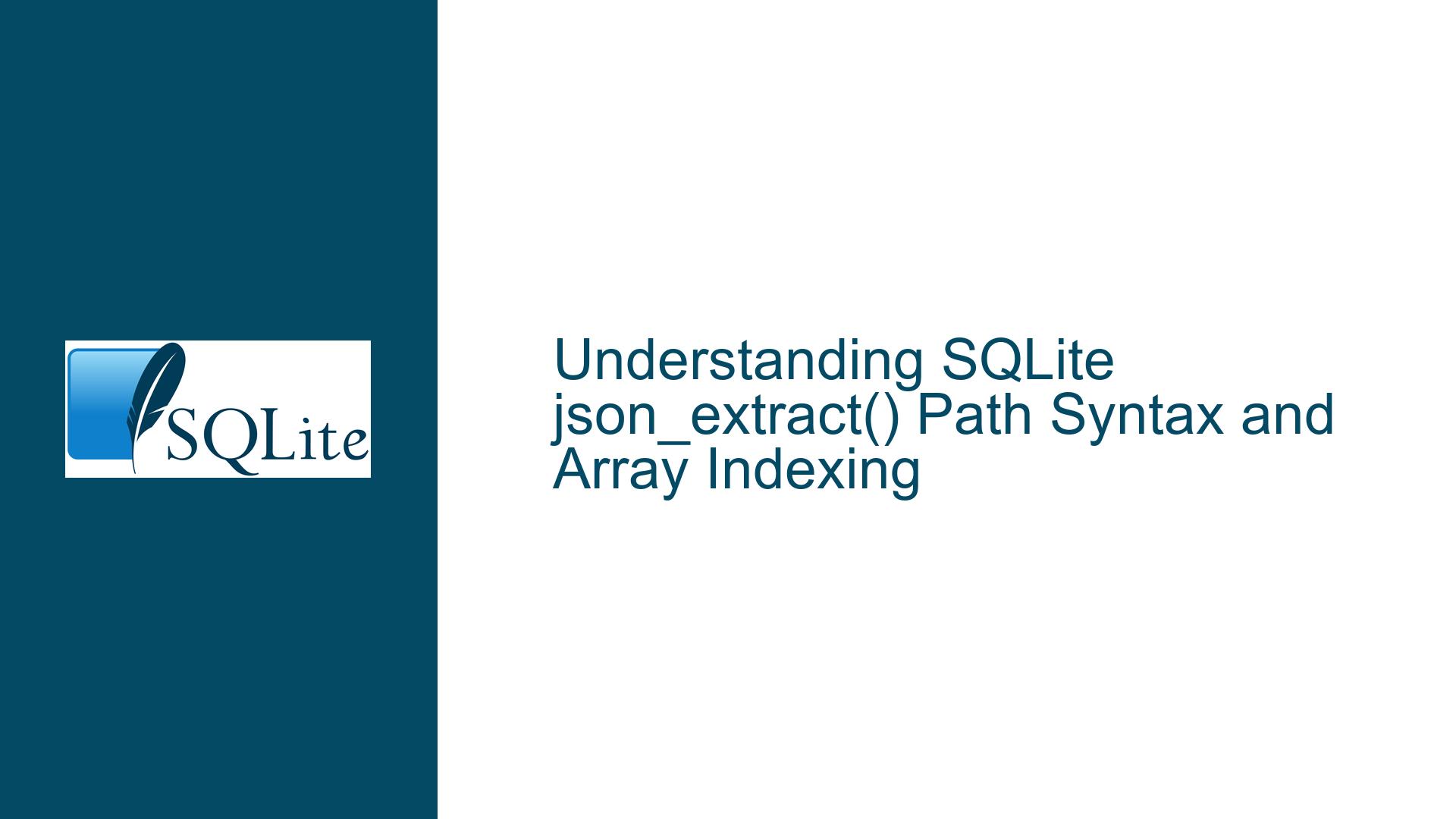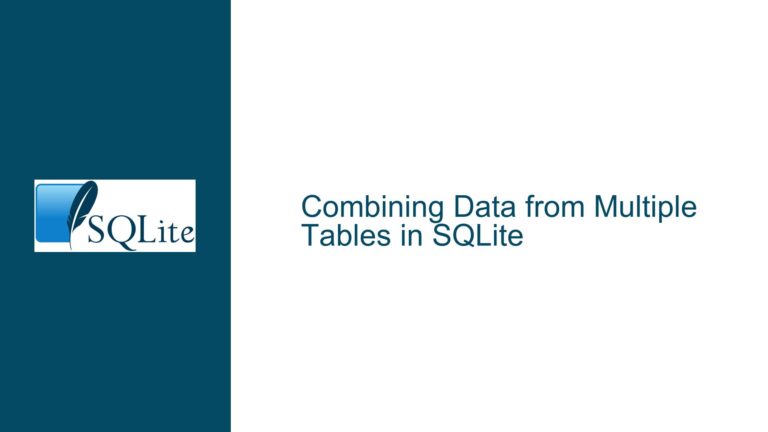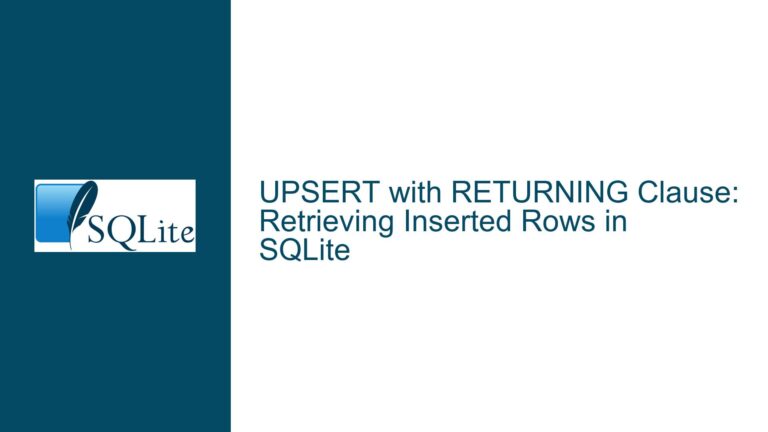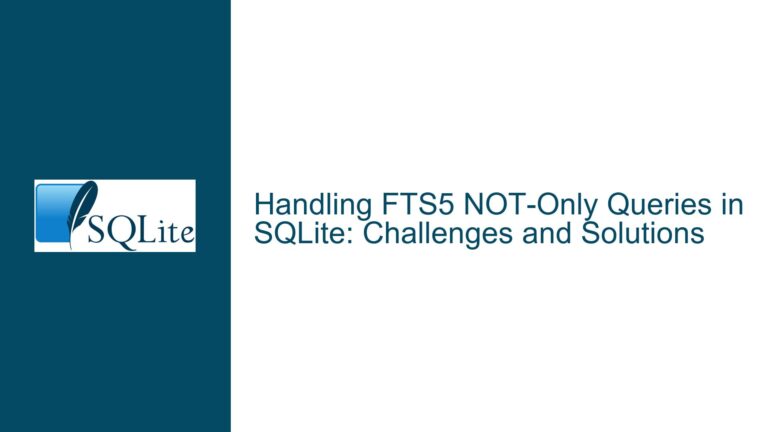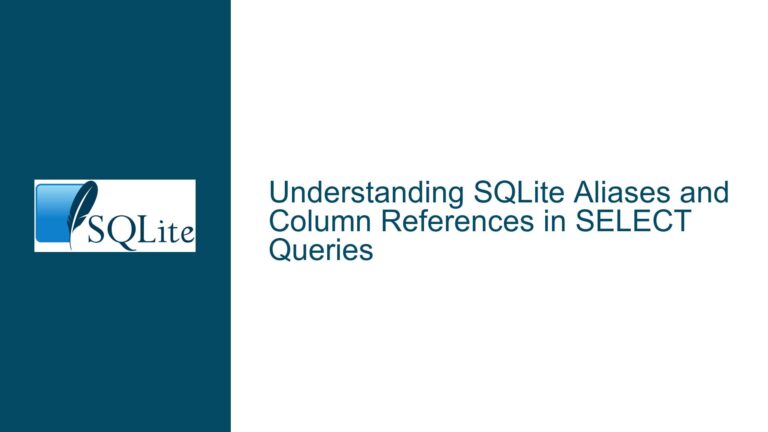SQLite json_extract() Path Syntax and Array Indexing
JSON Path Syntax Complexity in SQLite’s json_extract() Function
Core Challenge: Interpreting Array Index Modifiers and Key Quoting Rules
The central challenge revolves around SQLite’s implementation of JSON path syntax for the json_extract() function, particularly two aspects:
- The meaning and behavior of array index modifiers like
[#-1] - Proper techniques for accessing JSON object keys containing special characters (periods, quotes, brackets)
These elements create confusion due to SQLite-specific extensions that diverge from other database implementations and incomplete documentation about edge case handling. The syntax for array indexing using # (array size operator) and negative indices requires explicit explanation, as does the mechanism for escaping special characters in JSON keys through quoted path components.
Root Causes of Confusion in Path Expression Interpretation
Three primary factors contribute to misunderstandings:
1. Hybrid Syntax Borrowing With Extensions
SQLite’s JSON path syntax draws inspiration from MySQL’s JSON path implementation but adds unique features like the # operator for array size references. This creates a "mixed dialect" scenario where users familiar with MySQL expect identical behavior but encounter SQLite-specific behaviors such as:
[#-N]syntax for right-relative array indices- Mandatory quoting for keys containing
.or[characters - Backslash escaping within unquoted key identifiers
2. Documentation Structure Gaps
While the JSON1 documentation describes path syntax, critical details are buried in sections not directly linked from function-specific pages like json_extract(). Key omissions include:
- No cross-reference between function documentation and path syntax definitions
- Incomplete examples of escape sequences for quotes within quoted keys
- Lack of explicit warning about SQLite-specific features versus standards
3. Compound Special Character Handling
Nested special characters in JSON keys create complex escaping requirements. For example, a key like key."with[brackets].and"quotes requires multiple layers of escaping that interact unexpectedly:
- SQLite string literals use single quotes, requiring double quotes inside to remain unescaped
- JSON path syntax requires backslash-escaping within unquoted keys but allows alternative quoting styles
- JSON standard escaping rules (backslash in strings) vs. SQLite path parser rules create ambiguity
Comprehensive Resolution Strategy for Path Syntax Issues
Step 1: Decoding Array Index Modifiers
a. Basic Array Access
JSON arrays are 0-indexed. Use [N] to access the (N+1)th element:
-- Third element (index 2) of array 'c'
SELECT json_extract('{"c":[4,5,{"f":7}]}', '$.c[2]'); -- Returns '{"f":7}'
b. Right-Relative Indexing with #
The # symbol represents the array’s length. Combine with negative offsets for end-relative access:
-- Last element: length - 1
SELECT json_extract('{"c":[4,5,6]}', '$.c[#-1]'); -- Returns 6
-- Second from last: length - 2
SELECT json_extract('{"c":[4,5,6]}', '$.c[#-2]'); -- Returns 5
c. Implementation-Specific Constraints
#only works in array index expressions, not object key lookups- Calculations must resolve to non-negative integers:
$.arr[#-0]is invalid (index -0 = 0, but #-0 = length – 0 = length which is out of bounds) - Nesting
#in expressions isn’t supported:$.arr[#-N]where N is another # reference won’t work
Step 2: Mastering Key Quoting and Escaping
a. Simple Keys Without Special Characters
When keys contain only alphanumerics and underscores, no quoting needed:
SELECT json_extract('{"simpleKey":123}', '$.simpleKey'); -- 123
b. Mandatory Quoting for Special Characters
Keys with ., [, ], or space require double-quoted paths:
-- Key with period
SELECT json_extract('{"key.with.dots":456}', '$."key.with.dots"'); -- 456
-- Key with bracket
SELECT json_extract('{"key[with]bracket":789}', '$."key[with]bracket"'); -- 789
c. Escaping Quotes Within Keys
To handle keys containing double quotes, use backslash escaping outside of quoted path components:
-- JSON: {"key\"with"quote": 123}
SELECT json_extract('{"key\"with\"quote":123}', '$.key\"with\"quote'); -- 123
-- Alternative with quoting
SELECT json_extract('{"key\"with\"quote":123}', '$."key\"with\"quote"'); -- Error!
-- Correct approach:
SELECT json_extract('{"key\"with\"quote":123}', '$."key\"with\"quote"');
-- Fails due to parser confusion between SQL and JSON escaping
d. Combined Special Characters
For keys mixing quotes and other special characters, use strategic quoting:
-- JSON: {"crazy"key.[]": true}
-- Incorrect:
json_extract(..., '$.crazy"key.[]')
-- Correct:
json_extract(..., '$."crazy\"key.[]"')
-- Requires JSON string escaping AND path quoting:
UPDATE docs SET path = '$."crazy\"key.[]"' WHERE ...;
Step 3: Cross-Platform Syntax Considerations
a. MySQL vs. SQLite Path Differences
| Feature | MySQL | SQLite |
|---|---|---|
| Last array element | $[last] | $[#-1] |
| Key with space | $."key with space" | Same |
| Range slicing | $[1 to 3] | Not supported |
b. Porting JSON Paths Between Databases
- Replace MySQL’s
lastkeyword with#-1in SQLite - Avoid range operators (
to,until) - Test all key quotations – MySQL allows single quotes in paths, SQLite requires double
Step 4: Debugging Complex Path Expressions
a. Validation Technique Using json_valid() and Stepwise Extraction
WITH data(json_str) AS (
VALUES('{"a":2,"c":[4,5,{"f":7}], "strange.key\"": [10,11]}')
)
SELECT
json_valid(json_str) AS is_valid, -- First check JSON integrity
json_extract(json_str, '$') AS full_json,
json_extract(json_str, '$.c') AS array_c,
json_extract(json_str, '$.c[2]') AS third_element,
json_extract(json_str, '$.c[2].f') AS nested_value,
json_extract(json_str, '$."strange.key\""') AS quoted_key,
json_extract(json_str, '$."strange.key\""[1]') AS quoted_key_array
FROM data;
b. Common Error Patterns and Fixes
| Error Message | Cause | Fix |
|---|---|---|
| "malformed JSON path" | Unclosed quotes, invalid # usage | Check quote balance; avoid # outside array indices |
| "no such column" | Key with special chars not quoted | Wrap key in double quotes: $."key.with.dots" |
| "JSON cannot be BLOB" | Input isn’t valid JSON string | Validate JSON with json_valid(); cast BLOBs to TEXT |
| "integer required" | Non-integer array index like $.arr["key"] | Use numeric indices for arrays |
Step 5: Advanced Path Expression Engineering
a. Dynamic Index Calculations
Combine json_array_length() with json_extract() for runtime-determined indices:
SELECT json_extract(
json_data,
'$.array[' || (json_array_length(json_data, '$.array') - 1) || ']'
)
FROM table;
-- Equivalent to $.array[#-1] but using SQL expressions
b. Recursive JSON Unwinding
Extract nested elements through path concatenation:
SELECT
json_extract(json_data, '$.level1[0].level2') AS l2,
json_extract(json_data, '$.level1[0].level2.level3') AS l3
FROM multi_level_json;
c. Combining Multiple Extractions
Use the multi-argument form of json_extract() to fetch multiple paths as a JSON array:
SELECT json_extract('{"a":1,"b":2}', '$.a', '$.b'); -- Returns '[1,2]'
-- Equivalent to JSON_ARRAY(json_extract(data, '$.a'), json_extract(data, '$.b'))
Step 6: Proactive Documentation and Testing Strategies
a. Unit Test Pattern for JSON Paths
Create a validation table that checks edge cases:
CREATE TABLE json_path_tests (
test_name TEXT PRIMARY KEY,
json_input TEXT CHECK (json_valid(json_input)),
path_expression TEXT,
expected_result TEXT
);
INSERT INTO json_path_tests VALUES
('Last array element', '[1,2,3]', '$[#-1]', '3'),
('Quoted key with quote', '{"key\"": 42}', '$."key\""', '42'),
('Nested special chars', '{"a.b[c]": {"d\"e": 5}}', '$."a.b[c]"."d\"e"', '5');
SELECT test_name,
json_extract(json_input, path_expression) = expected_result AS passed
FROM json_path_tests;
b. Documentation Improvement Proposals
- Add cross-links between
json_extract()documentation and path syntax definitions - Include table comparing SQLite vs MySQL path features
- Expand examples for:
- Triple escaping (SQL string → JSON path → JSON string)
- Negative array indices without
#(e.g.,[-1]vs[#-1])
- Clarify that
#is SQLite-specific through warning callouts
c. Community Knowledge Sharing
- Create a decision flowchart for path syntax:
Start → Key has special chars? → Yes → Use double quotes ↓ ↓ Use bare key Escape inner quotes with \ ↓ ↓ Array access? → Yes → Use [N] or [#-N] - Publish an interactive SQL Fiddle demonstrating edge cases
- Contribute test cases to SQLite’s regression test suite
Final Implementation Checklist
Array Indexing
- Use
[#-1]instead oflastor-1for last element - Verify indices don’t exceed
json_array_length() - 1
- Use
Key Quoting
- Always quote keys with
.,[,], or space - Use backslash escapes outside quoted paths for contained quotes
- Always quote keys with
Cross-Database Porting
- Replace MySQL-specific syntax with SQLite equivalents
- Test all JSON paths after conversion
Validation
- Use
json_valid()before extraction - Test complex paths with stepwise evaluation
- Use
By methodically applying these steps, developers can overcome ambiguities in SQLite’s JSON path implementation, properly handle special cases, and write robust queries that leverage json_extract()‘s full capabilities while avoiding common pitfalls.
